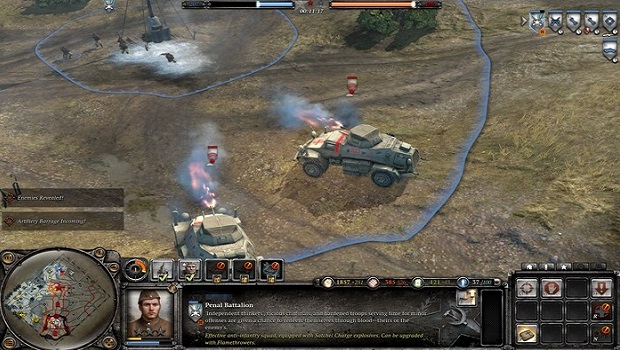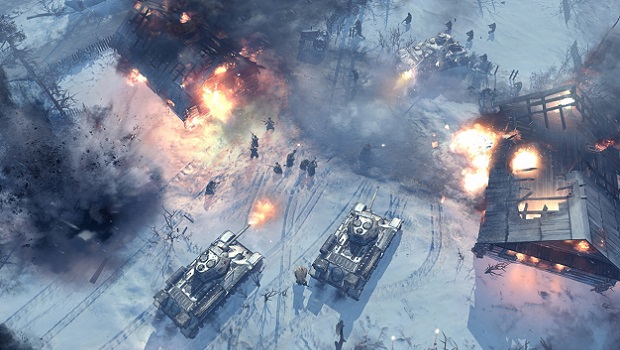I wrote my senior thesis on what Russians call the Great Patriotic War. The German invasion of the USSR resulted in what would probably rank as one the most horrific conflicts in human history. The scale of destruction was vast, and the death toll unimaginable. The vast majority of Holocaust victims were from Soviet territories, but that was only a portion of the more than 20 million citizens and soldiers of Mother Russia and her client states that perished in the conflict. Germany and her allies were certainly responsible for a large number of these deaths, but Stalin’s Communist regime certainly contributed to the butcher’s bill with its policies and purges. It is against this backdrop that Relic Entertainment sets its highly anticipated sequel, Company of Heroes 2.
Company of Heroes 2 is a real time strategy game in which you command single tanks, guns and squads of six men in combat. In practice, it’s functionally identical to the original. Squads can garrison buildings and take cover behind objects, all of which are completely destructible. Battles are confused but beautiful affairs, as infantry get pinned under machine gun fire, artillery brings down buildings, and tanks see their guns damaged and engines destroyed before they explode. Control over units is a frantic experience, one that really draws the player into the sense of a World War II firefight. One major upgrade is the addition of Tru-Sight. Instead of using the RTS trope of units being able to see any enemy in a certain radius, units now factor in line of sight. Enemy tanks will drop in and out of vision as they move on the horizon, and you’ll normally hear them long before you see them.
I still find myself wishing that individual unit AI was a little more robust. Infantry caught in the open at least has the good sense to get down. Given that, it’s strange that tanks and guns that are flanked to show a rear facing to an enemy unit will sit and take damage until they are destroyed (assuming you don’t actively instruct them differently). In a widespread battle it can be difficult to move units in this fashion. Still, the original was one of the best games in the business in terms of control, ease of ordering units to the front, and rewarding players well for unit conservation, and this is no different. Units successful in combat gain XP, leveling up and increasing their stats. Fully upgraded Russian T-34 tanks are a force to be reckoned with, meaning that when I used them in battle, I was careful to use them without losing them, and repaired them with my engineers at every opportunity.
This game introduces Russians to the series for the first time, and they are represented in fine fashion. During the campaign, you’ll have access to hordes of conscripts, infantry which while not powerful on their own, can be used as replacements for any other squad you already have in combat. Calling them onto the field will, unfortunately, also bring onto the map commissars. Commissars are political officers who, for a short time, will execute any retreating Russian forces, which adds a compelling Russian-only flavor to the game. The Russians also have access to Katyusha rockets, not the most accurate form of artillery but deadly to enemy infantry and expert at taking down buildings. The Russians are a well-developed faction with their own unique quality and certainly add a compelling new angle into the series.
The first Company of Heroes took place during the Normandy Invasion, a celebration of heroism and a tribute to immense sacrifice. Overlord (the D-Day invasion) is one of the most symbolic campaigns in the entire American ethos, and the positive bent on that conquest, one of freedom from Nazi tyranny and oppression, falls in stark contrast to the portrayal of CoH 2’s Russian front. Life on WW2’s Eastern Front is grim and desperate. The storyline focuses, rather extensively, on the reality that Soviet soldiers had as much to fear from their own commanders as they did from the enemy. Repeatedly, the game emphasizes that soldiers are to be automatons, behaving according to their orders without question and without regard to their own personal safety. Those in violation of that condition face instant death.
It’s an interesting contrast to have such a negative storyline in a campaign. It is also used so much that the dead horse is dug up so that it may once again be shot in the head. The complete lack of character development, however, makes it difficult to sympathize with the plights of the soldiers. When anonymous characters are summarily executed, I feel nothing (especially after a two hour mission where I repeatedly ordered troops to their death). The campaign makes little attempt to tell a cohesive story, bouncing across several of the war’s major campaigns without focus or regard for narrative. We are left with a series of disconnected missions, unified only by a narrator who, supposedly, was on the field (even though he never appears during live gameplay). After the excellent storytelling of the original game, the campaign here is a disappointment, taking what was previously an exciting element and making it a slog.
The missions themselves are run of the mill, save for two. The lack of compelling gameplay situations is telling. The game introduces an all new gameplay element in which bitter cold harms troops outside, forcing them to seek shelter or fires. It’s a compelling idea that really forces some interesting nuance into the gameplay. Sadly, it only appears in the single player in one mission. One mission pits your small force of infantry, without any significant anti-tank weaponry, against a solitary but fearsome Tiger tank. This was the high point of the campaign for me, as I had to scavenge for spit wads, using my poor troops as bait to draw the tank into an alleyway where I could hit it with everything I could. Ultimately, though, the campaign falls flat, undermined by a large number of run-of-the-mill missions combined with the ability to summon conscripts at any time (meaning your armies are always packed with troops). The missions are fun, and some are uniquely compelling, but most lack that special feeling that all of the missions of the game’s predecessor accomplished.
Company of Heroes 2 largely exists to upgrade the multiplayer component of the series. With multiplayer given such a starring role, it’s unsurprising that the game rolls out a robust leveling mechanic, with large numbers of unlockable challenges. Challenges are mostly pretty mundane, like using a Katyusha’s barrage ability 100 times or killing 100 panzergrenadiers with a machine gun. They do provide small percentage bonuses, provided you have reached the proper level. There are a lot of levels and tons of challenges, some of which you’ll never complete without a lot of grinding. Hundreds of hours of play would be necessary to complete everything.
With the multiplayer focus, it’s great that the game has focused more on refining on its predecessor. This allows veteran players to hop in and immediately understand what’s going on. The snow levels will provide a unique experience, and you’ve never seen a battlefield go from maelstrom to utter quiet quite so quickly as when a blizzard rolls through, forcing all your units to run into warm, protected areas, lest they die. The multiplayer is a lot of fun, and if you played the first game, you’ll find yourself with the leveling system and some great new maps with unique attributes to keep you entertained.
If you’re a first time player, however, you’ll find yourself utterly intimidated. The single player campaign, while versing you well in combat versus the AI, does little to prepare you either for the challenge of facing another player or (more importantly) introduce you properly to the building construction/leveling mechanics. Learning combat under fire is one thing. Doing that while trying to figure out build order is impossible. The game will lose a lot of new players since it never bothered to explain which building does what, the connections between buildings, and other similar issues. A proper multiplayer tutorial would have been nice.
Company of Heroes 2 is a fine continuation of the series, though it seems to fall short of the genre-defining nature of its predecessor. The campaign is fun, even if it fails to make full use of the new mechanics and weather effects to full effect. The additions to multiplayer are useful, even if the game is not particularly welcoming to new players. All in all, the game overcomes its faults by making compelling additions to the framework laid out by its predecessor. Despite its depressing campaign narrative, this is an effort to be greatly enjoyed.




